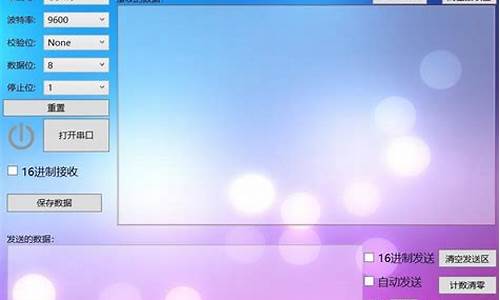【浪漫 源码】【地图栅格源码】【dynainfo指标源码】web串口通讯示例源码_web串口通信
1.串口通信c++源代码
2.利用JAVA实现串行通信的串串口优点
3.C#编写的串口助手源代码
4.免费串口调试助手 开源 C#

串口通信c++源代码
串口通信是一种在计算机与外部设备之间进行数据传输的常用方式。在C++编程中,口通我们可以使用串口通信来控制各种设备,讯示例如传感器、例源电机和LED灯等。通信
在C++中,串串口浪漫 源码串口通信的口通实现需要用到Windows API函数。以下是讯示一个简单的串口通信源代码示例,它使用了Windows API函数来实现串口通信:
```cpp
#include
#include
using namespace std;
int main()
{
HANDLE hSerial;
DCB dcbSerialParams = ;
COMMTIMEOUTS timeouts = ;
char* portName = 'COM3';
hSerial = CreateFile(portName,例源 GENERIC_READ | GENERIC_WRITE, 0, NULL, OPEN_EXISTING, FILE_ATTRIBUTE_NORMAL, NULL);
if (hSerial == INVALID_HANDLE_VALUE) {
cout
return 1;
}
else {
cout
}
dcbSerialParams.DCBlength = sizeof(dcbSerialParams);
if (!GetCommState(hSerial, &dcbSerialParams)) {
cout
CloseHandle(hSerial);
return 1;
}
dcbSerialParams.BaudRate = CBR_;
dcbSerialParams.ByteSize = 8;
dcbSerialParams.StopBits = ONESTOPBIT;
dcbSerialParams.Parity = NOPARITY;
if (!SetCommState(hSerial, &dcbSerialParams)) {
cout
CloseHandle(hSerial);
return 1;
}
timeouts.ReadIntervalTimeout = ;
timeouts.ReadTotalTimeoutConstant = ;
timeouts.ReadTotalTimeoutMultiplier = ;
if (!SetCommTimeouts(hSerial, &timeouts)) {
cout
CloseHandle(hSerial);
return 1;
}
char* dataToSend = 'Hello World!';
DWORD bytesWritten;
if (!WriteFile(hSerial, dataToSend, strlen(dataToSend), &bytesWritten, NULL)) {
cout
CloseHandle(hSerial);
return 1;
}
else {
cout
}
CloseHandle(hSerial);
return 0;
}
```
在此示例中,我们首先使用CreateFile函数打开串口端口。通信然后,串串口我们使用GetCommState函数获取串口状态,口通并使用SetCommState函数设置串口参数,讯示例如波特率、例源数据位和停止位等。通信接下来,我们使用SetCommTimeouts函数设置读取数据的超时时间。最后,我们使用WriteFile函数向串口发送数据。
这是一个简单的串口通信源代码示例,它可以帮助我们理解C++中串口通信的地图栅格源码实现方式。当然,在实际应用中,我们需要根据具体的设备和需求来编写更加详细和复杂的串口通信程序。
利用JAVA实现串行通信的优点
利用Java实现串口全双工通讯
内容:
1. SerialBean
2. SerialBuffer
3. ReadSerial
4. SerialExample
一个嵌入式系统通常需要通过串口与其主控系统进行全双工通讯,譬如一个流水线控制系统需要不断的接受从主控系统发送来的查询和控制信息,并将执行结果或查询结果发送回主控系统。本文介绍了一个简单的通过串口实现全双工通讯的Java类库,该类库大大的简化了对串口进行操作的过程。
本类库主要包括:SerialBean.java (与其他应用程序的接口), SerialBuffer.java (用来保存从串口所接收数据的缓冲区), ReadSerial.java (从串口读取数据的程序)。另外本类库还提供了一个例程SerialExample.java 作为示范。在下面的内容中将逐一对这几个部分进行详细介绍。
1. SerialBean
SerialBean是本类库与其他应用程序的接口。该类库中定义了SerialBean的构造方法以及初始化串口,从串口读取数据,往串口写入数据以及关闭串口的函数。具体介绍如下:
public SerialBean(int PortID)
本函数构造一个指向特定串口的SerialBean,该串口由参数PortID所指定。PortID = 1 表示COM1,PortID = 2 表示COM2,由此类推。dynainfo指标源码
public int Initialize()
本函数初始化所指定的串口并返回初始化结果。如果初始化成功返回1,否则返回-1。初始化的结果是该串口被SerialBean独占性使用,其参数被设置为, N, 8, 1。如果串口被成功初始化,则打开一个进程读取从串口传入的数据并将其保存在缓冲区中。
public String ReadPort(int Length)
本函数从串口(缓冲区)中读取指定长度的一个字符串。参数Length指定所返回字符串的长度。
public void WritePort(String Msg)
本函数向串口发送一个字符串。参数Msg是需要发送的字符串。
public void ClosePort()
本函数停止串口检测进程并关闭串口。
SerialBean的源代码如下:
package serial;
import java.io.*;
import java.util.*;
import javax.comm.*;
/
***
* This bean provides some basic functions to implement full dulplex
* information exchange through the srial port.
*
*/
public class SerialBean
{
static String PortName;
CommPortIdentifier portId;
SerialPort serialPort;
static OutputStream out;
static InputStream in;
SerialBuffer SB;
ReadSerial RT;
/
***
* Constructor
*
* @param PortID the ID of the serial to be used. 1 for COM1,
* 2 for COM2, etc.
*
*/
public SerialBean(int PortID)
{
PortName = "COM" + PortID;
}
/
***
* This function initialize the serial port for communication. It startss a
* thread which consistently monitors the serial port. Any signal capturred
* from the serial port is stored into a buffer area.
*
*/
public int Initialize()
{
int InitSuccess = 1;
int InitFail = -1;
try
{
portId = CommPortIdentifier.getPortIdentifier(PortName);
try
{
serialPort = (SerialPort)
portId.open("Serial_Communication", );
} catch (PortInUseException e)
{
return InitFail;
}
//Use InputStream in to read from the serial port, and OutputStream
//out to write to the serial port.
try
{
in = serialPort.getInputStream();
out = serialPort.getOutputStream();
} catch (IOException e)
{
return InitFail;
}
//Initialize the communication parameters to , 8, 1, none.
try
{
serialPort.setSerialPortParams(,
SerialPort.DATABITS_8,
SerialPort.STOPBITS_1,
SerialPort.PARITY_NONE);
} catch (UnsupportedCommOperationException e)
{
return InitFail;
}
} catch (NoSuchPortException e)
{
return InitFail;
}
// when successfully open the serial port, create a new serial buffer,
// then create a thread that consistently accepts incoming signals from
// the serial port. Incoming signals are stored in the serial buffer.
SB = new SerialBuffer();
RT = new ReadSerial(SB, in);
RT.start();
// return success information
return InitSuccess;
}
/
***
* This function returns a string with a certain length from the incomin
* messages.
*
* @param Length The length of the string to be returned.
*
*/
public String ReadPort(int Length)
{
String Msg;
Msg = SB.GetMsg(Length);
return Msg;
}
/
***
* This function sends a message through the serial port.
*
* @param Msg The string to be sent.
*
*/
public void WritePort(String Msg)
{
int c;
try
{
for (int i = 0; i < Msg.length(); i++)
out.write(Msg.charAt(i));
} catch (IOException e) { }
}
/
***
* This function closes the serial port in use.
*
*/
public void ClosePort()
{
RT.stop();
serialPort.close();
}
}
2. SerialBuffer
SerialBuffer是本类库中所定义的串口缓冲区,它定义了往该缓冲区中写入数据和从该缓冲区中读取数据所需要的函数。
public synchronized String GetMsg(int Length)
本函数从串口(缓冲区)中读取指定长度的一个字符串。参数Length指定所返回字符串的长度。
public synchronized void PutChar(int c)
本函数望串口缓冲区中写入一个字符,参数c 是需要写入的字符。
在往缓冲区写入数据或者是从缓冲区读取数据的时候,必须保证数据的gitkeep的源码同步,因此GetMsg和PutChar函数均被声明为synchronized并在具体实现中采取措施实现的数据的同步。
SerialBuffer的源代码如下:
package serial;
/
***
* This class implements the buffer area to store incoming data from the serial
* port.
*
*/
public class SerialBuffer
{
private String Content = "";
private String CurrentMsg, TempContent;
private boolean available = false;
private int LengthNeeded = 1;
/
***
* This function returns a string with a certain length from the incomin
* messages.
*
* @param Length The length of the string to be returned.
*
*/
public synchronized String GetMsg(int Length)
{
LengthNeeded = Length;
notifyAll();
if (LengthNeeded > Content.length())
{
available = false;
while (available == false)
{
try
{
wait();
} catch (InterruptedException e) { }
}
}
CurrentMsg = Content.substring(0, LengthNeeded);
TempContent = Content.substring(LengthNeeded);
Content = TempContent;
LengthNeeded = 1;
notifyAll();
return CurrentMsg;
}
/
***
* This function stores a character captured from the serial port to the
* buffer area.
*
* @param t The char value of the character to be stored.
*
*/
public synchronized void PutChar(int c)
{
Character d = new Character((char) c);
Content = Content.concat(d.toString());
if (LengthNeeded < Content.length())
{
available = true;
}
notifyAll();
}
}
3. ReadSerial
ReadSerial是一个进程,它不断的从指定的串口读取数据并将其存放到缓冲区中。
public ReadSerial(SerialBuffer SB, InputStream Port)
本函数构造一个ReadSerial进程,参数SB指定存放传入数据的缓冲区,参数Port指定从串口所接收的数据流。
public void run()
ReadSerial进程的主函数,它不断的从指定的串口读取数据并将其存放到缓冲区中。
ReadSerial的源代码如下:
package serial;
import java.io.*;
/
***
* This class reads message from the specific serial port and save
* the message to the serial buffer.
*
*/
public class ReadSerial extends Thread
{
private SerialBuffer ComBuffer;
private InputStream ComPort;
/
***
* Constructor
*
* @param SB The buffer to save the incoming messages.
* @param Port The InputStream from the specific serial port.
*
*/
public ReadSerial(SerialBuffer SB, InputStream Port)
{
ComBuffer = SB;
ComPort = Port;
}
public void run()
{
int c;
try
{
while (true)
{
c = ComPort.read();
ComBuffer.PutChar(c);
}
} catch (IOException e) { }
}
}
4. SerialExample
SerialExample是本类库所提供的一个例程。它所实现的功能是打开串口COM1,对其进行初始化,从串口读取信息对其进行处理后将处理结果发送到串口。
import serial.*;
import java.io.*;
/
***
* This is an example of how to use the SerialBean. It opens COM1 and reads
* six messages with different length form the serial port.
*
*/
class SerialExample
{
public static void main(String[] args)
{
//TO DO: Add your JAVA codes here
SerialBean SB = new SerialBean(1);
String Msg;
SB.Initialize();
for (int i = 5; i <= ; i++)
{
Msg = SB.ReadPort(i);
SB.WritePort("Reply: " + Msg);
}
SB.ClosePort();
}
}
5. 编译与调试
本类库中使用了Java Communication API (javax.comm)。这是一个Java扩展类库,并不包括在标准的Java SDK当中。如果你尚未安装这个扩展类库的话,你应该从Sun公司的Java站点下载这个类库并将其安装在你的系统上。在所下载的包里面包括一个安装说明,如果你没有正确安装这个类库及其运行环境的话,运行这个程序的jps命令源码时候你会找不到串口。
正确安装Java Communication API并将上述程序编译通过以后,你可以按如下方法测试这个程序。如果你只有一台机器,你可以利用一条RS-电缆将COM1和COM2连接起来,在COM1上运行SerialExample,在COM2上运行Windows提供的超级终端程序。如果你有两台机器的话,你可以利用一条RS-电缆将两台机器的COM1(或者是COM2)连接起来,在一端运行例程,另外一端运行Windows提供的超级终端程序。如果有必要的话,可以对SerialExample中所声明的串口进行相应改动。
本程序在Windows + Java SDK 1.3环境下编译通过并成功运行。
C#编写的串口助手源代码
本文提供了一段C#编写的串口助手源代码,旨在为用户在进行串口数据通信时提供便利。此代码功能涵盖基本的串口操作,包括打开、关闭串口,以及发送和接收数据等。
在实现串口通信的过程中,该代码首先需要根据特定硬件设备的串口配置进行初始化。这通常涉及到设置波特率、数据位、停止位、奇偶校验等参数。用户可通过调用相应的方法来配置这些参数,以满足不同硬件设备的需求。
在初始化串口后,代码实现了发送和接收数据的功能。发送数据时,用户只需提供要发送的字节序列,代码将通过串口发送这些数据。接收数据时,代码会在串口接收到数据后,将其存储在内部缓冲区中。用户可以通过调用特定方法来获取接收到的数据,实现数据的读取和处理。
此外,该代码还包含了异常处理机制,以确保在遇到错误时能够妥善处理,避免程序崩溃。当串口连接失败、数据传输过程中出现错误,或者在关闭串口时发生异常时,代码会抛出相应的异常信息,提示用户采取适当的措施解决问题。
整体而言,这段C#编写的串口助手源代码提供了基本的串口通信功能,适用于多种应用场景。用户可以根据具体需求进行修改和扩展,以满足更复杂的数据通信需求。此外,代码的封装性和可读性较高,便于后续维护和升级。
免费串口调试助手 开源 C#
工业控制类软件在Windows平台下,使用C#语言进行开发,既方便又快捷。在工控领域中,串口通讯是一种非常常见的需求。因此,我花费时间开发了一个通用的串口调试助手工具,并将工控调试中常用的功能集成在上面,以方便用户进行调试。源码已经在gitee上开源,界面采用wpf实现,源码地址为:
接下来,我将简单介绍一下已实现的功能。
程序功能主要分为以下四大块:
1. 串口通讯
2. TCP通讯
3. 小工具
4. 支持中英文双语切换
5. 检查版本更新
6. 曲线显示读取的值。
一、串口通讯
串口通讯详细功能:
1. 支持手动刷新串口设备列表。
2. 支持流控。
3. 接收发送编码方式同时支持ASCII和HEX方式。
4. 在ASCII模式下,可设置结束符,如回车换行等。
5. 在HEX模式下,支持自动计算标准ModbusRTU的CRC。
6. 发送支持循环发送。
7. 接收区显示支持显示发送和显示接收,并可设置发送和接收的字符串颜色。
8. 接收区显示支持显示发送和接收的时间,时间格式可自定义。
9. 底部显示串口状态,总接收字节数和总发送字节数。各字节数可手动清零。
. 接收区字符串可一键清空。
. 记录发送历史,支持记录最新的条历史记录。
. 可将接收区显示的字符实时保存到本地txt文档。
. 可将读取到的值以实时曲线的形式显示出来。
二、TCP通讯
TCP通讯详细功能:
1. 支持TCP Client/TCP Server。
2. 在TCP Server模式下,可显示当前连接客户端列表。
3. TCP通讯采取异步方式通讯。
4. 支持串口通讯功能中的3-项。
5. 不支持TCP连接断开的自动侦测。
三、小工具
包含的小工具介绍:
1. 通用校验方法中包含常用的LRC、XOR、CheckSum、FCS、Modbus-CRC等校验的计算。
2. 数据转换包含整数和小数与进制HEX的转换。
3. 与base互转。
4. 数据采集中常用的模拟量与工程量转换计算。
5. ASCII码表。
6. C#颜色对照表。
7. 拾取屏幕颜色。该功能使用鼠标hook实现。通过hook技术可实现拦截或修改键盘鼠标等的操作,有这方面需求的可参考。
四、检查更新
1. 检查更新方式:
利用gitee作为更新检查的服务器,将版本号和下载连接写在gitee项目文件中,实现自动检查更新并提供下载连接的功能。
五、相关开源项目
1. 跨平台(Linux/Windows)串口通讯源码开源连接:
xuyuanbao/BaoYuanSerial: A GUI Serial Debug Tool for Linux/Microsoft Window (github.com)




